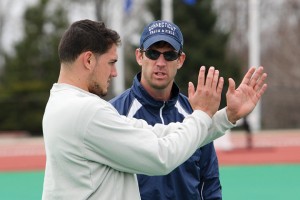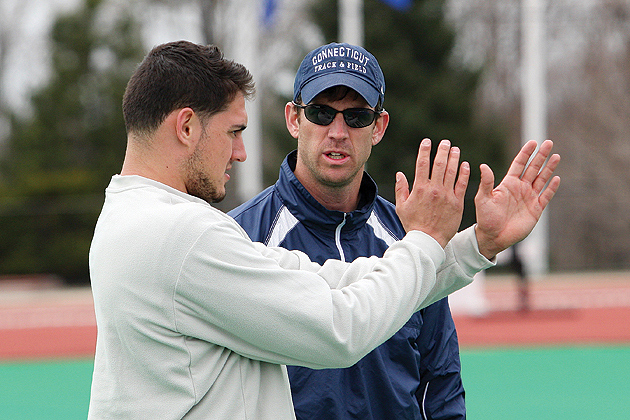RICH MILLER ’95 (ED) GUIDES RUNNERS OVER CHALLENGES OF HILLS, FIELDS, AND WOODS
Rich Miller ’95 (ED) is head coach of men’s cross country and associate head coach of men’s track and field. He has been part of the Huskies’ coaching staff for 16 years, and as a student-athlete was named the 1995 UConn Club Outstanding Scholar-Athlete. He was a co-captain of the track and field teams that won back-to-back New England Indoor Championships. He spoke with UCONN Magazine about coaching men’s cross country.
What should people know first about cross country?

We race over five miles in the woods and in the fields. Each course varies in the level of difficulty because of the terrain we run on. You have both individuals competing and a team competition. You are scored based on the place that you come in – you get one point for being in first place, 30 points for being in 30th place – as well as the time you have. You add up the points for the top five runners on the team, and that’s the score you come in with. It’s like golf in that the lowest score wins.
What makes a good championship course?
A challenging course. Runners have different strengths and weakness, and you have some runners who may favor the hillier course, some who favor a flat course, or those that are good in the fields or the woods. The weather also plays a factor. Some courses get muddy when it’s raining, and others drain pretty well. To me, a good championship course combines a lot of things, giving you some flat running as well as open running.
Is most of the team’s training done on or off campus?
One of the great things about being here is there are a lot of varied routes nearby. We have some traditional loops on campus here: near Mirror Lake, Horsebarn Hill, and some trails up the fields behind Charter Oak in the woods. We’ll also go down to Mansfield Hollow a number of times during the year. It’s great training for these guys.
Is it difficult that you don’t have the chance to coach your student-athletes as they are competing in cross country as other coaches in other team sports can do?
There’s always final minute adjustments right before the competition starts but, by and large, most of the work has happened already, leading up to that competition. There is a race plan for the kids to be disciplined, aggressive, and to follow the plan set up for them. Success or failure will be based on that. It is unique in that once the race starts, you turn into a cheerleader.
What are the elements of a race plan?
I believe in racing aggressively and in putting yourself in a position to win and not waiting for something to happen. A lot of it starts with mental preparation and race concepts. We work on understanding the benchmark is running five-minute miles over a five- to six-mile race. If you’re able to run at that level, by and large, you’re going to be successful. Guys need to be in position as they move into the rest of the race. And you need to do it without exerting the energy you need for the rest of the race.
What do you feel is unique about cross country racing at the intercollegiate level?
One of the great things in the sport is that we’re all starters. There’s no looking around for someone to take the ball away from you. I have my opportunity to succeed or fail, be a champion – and it’s up to me, not the guy next to me. If I can be my best on the day that I’m preparing to be my best, nobody can take that away.



